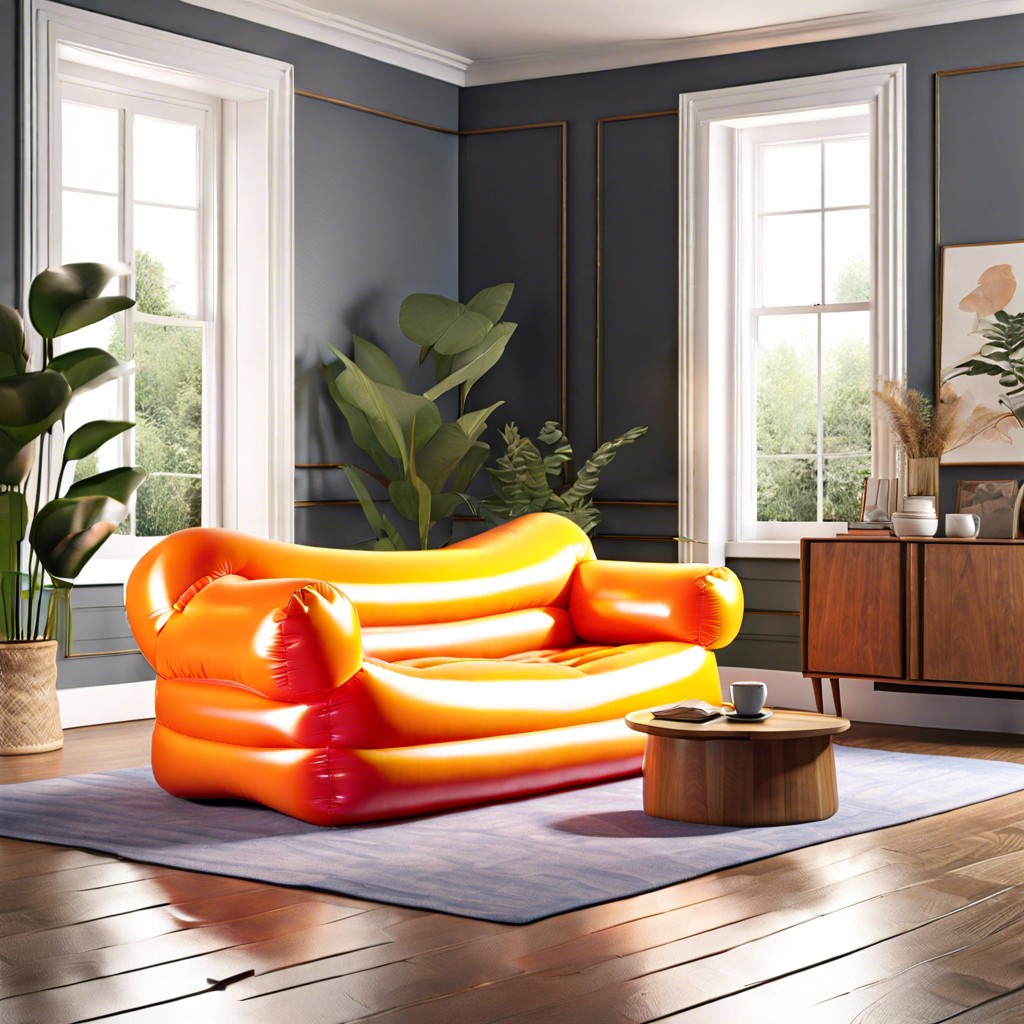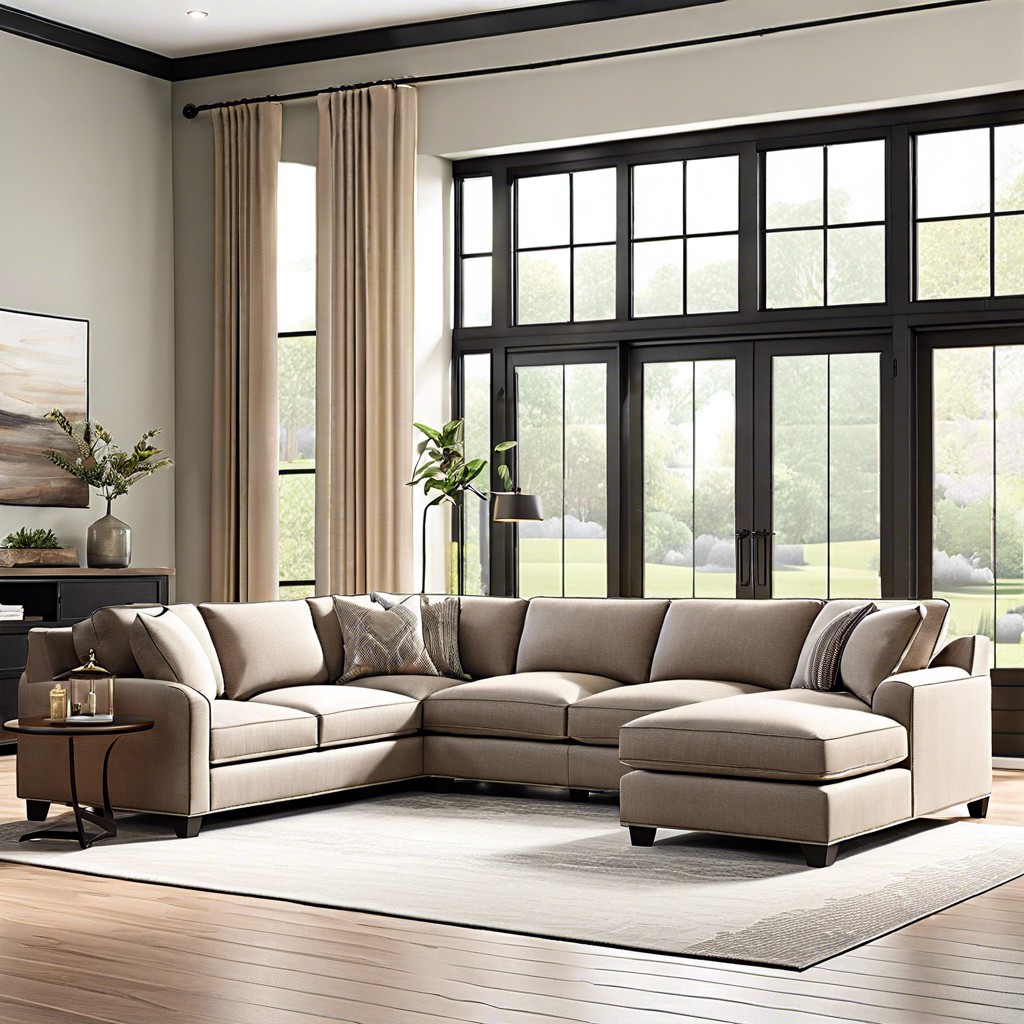Last updated on
In this article, you’ll learn the key differences between sectional sofas and traditional sofas to make an informed decision for your living space. Sectional sofas and traditional sofas differ in terms of configuration, size, and adaptability. A sectional is typically composed of multiple pieces that can be arranged in a variety of ways, making it a versatile choice for different room layouts. Its “L” or “U” shapes can accommodate more people and often include features like chaise lounges or recliners. Sectionals are ideal for larger spaces where the layout is meant to encourage conversation or for families needing ample seating. Traditional sofas, on the other hand, come in a single, fixed shape. They are generally suited to smaller spaces and standard living setups. With a variety of styles ranging from loveseats to full-size couches, they offer a streamlined and classic look. While they don’t offer the same flexibility as sectionals, traditional sofas can be easily paired with other furniture like armchairs and ottomans to complete a room’s design. When choosing between a sectional and a traditional sofa, consider room size, desired seating capacity, and personal style preferences. Additionally, think about movability; sectionals can be harder to move due to their size and the number of components, which could be an important factor for those who relocate often. A traditional sofa offers ease of mobility and could be a more practical choice for renters or individuals who prefer a changeable living space.
Key takeaways:
- Sectionals are versatile and ideal for larger spaces.
- Traditional sofas offer a classic and streamlined look.
- Consider room size, seating capacity, and personal style.
- Sectionals maximize seating, sofas offer flexibility.
- Reflect on room layout, traffic flow, and intended use.
Table of Contents
Types of Sofas

Sofas come in various forms, tailored to fit different spaces and styles. The traditional sofa, typically designed for three people, is the most common. Its straightforward design incorporates two armrests and a uniform back.
Loveseats, a smaller version of the sofa, comfortably seat two people and work well in cozy spaces or paired with a larger sofa. The chesterfield, with its quilted or tufted style, adds a touch of elegance and historical charm.
Convertible sofas, such as futons or sleeper sofas, double as beds, offering a practical solution for overnight guests. Lastly, modular sofas feature separate pieces that can be rearranged to suit changing preferences or room configurations, providing flexibility not typically found in standard sofas.
Key Differences Between Sofas and Sectionals
Sofas generally refer to standalone pieces of furniture designed to seat two or more people. They come in various styles such as loveseats, three-seaters, or even grand sofas that can accommodate four or more. The primary appeal of a sofa is its versatility; it can be placed against a wall or float within a room to define different areas within a larger space.
Sectionals, on the other hand, are modular furniture pieces that connect to create a cohesive unit, often forming an L-shape or a U-shape. Despite being a single piece, sectionals offer the flexibility to fit into corners or provide ample seating that wraps around a focal point, such as a coffee table or television. They typically feature a chaise section for stretching out, making them ideal for lounging and casual entertaining.
Choosing between the two usually hinges on space and functionality desires. Sofas can be more suited to formal settings or smaller living rooms where space conservation is crucial. Sectionals maximize seating capacity and comfort, making them perfect for larger families or those who entertain frequently. The configuration of a sectional also lends itself to creating an inviting atmosphere that encourages interaction among guests.
Ultimately, whether one opts for the structured simplicity of a sofa or the expansive embrace of a sectional boils down to lifestyle, space constraints, and personal preference.
Room Layout Considerations
When determining whether a sectional or a sofa is the right choice, the room’s layout should inform your decision. Sectionals typically require more space and can dominate a room, especially L- or U-shaped designs. They work well in large living areas where they can help define the space and offer ample seating without the need for additional chairs.
Conversely, standard sofas offer more flexibility for different room shapes and sizes. They can be paired with loveseats, chairs, or chaises to create a fluid living room arrangement that can be reconfigured as needed. This can be particularly advantageous for smaller spaces or in rooms with multiple focal points, like a living room that doubles as an entertainment space.
Consider traffic flow as well. If the room sees high foot traffic, a sectional may block paths and create dead space. On the other hand, a sofa can be strategically placed to enhance movement within the room while still providing sufficient seating.
Lastly, take into account the room’s intended use. For a space meant for entertaining, a sectional might facilitate conversation by allowing guests to face each other. If the space is more for family use, a sofa with a separate recliner or armchair might better serve the room’s needs, giving individuals the option to spread out.
Personal Style and Aesthetics
Choosing between a sectional and a sofa isn’t just about space and functionality; it also significantly impacts the overall aesthetic of a room. Sofas exude a classic and structured appearance that can maintain an open and airy feel in your living space. They can be paired with chairs, ottomans, or loveseats to create a tailored look that reflects a more traditional or formal style.
On the other hand, sectionals offer a modern and cozy vibe that encourages lounging and casual gatherings. They often serve as a focal point, anchoring the room with their substantial form and providing a sense of warmth and inclusivity. For those who relish in contemporary design, a sectional may be the perfect statement piece that also maximizes seating capacity.
When pondering personal style, color, fabric, and design details come into play. Whether you prefer the clean lines of a mid-century modern sofa or the plush cushions of a deep-seated sectional, these elements should resonate with your personal taste and complement the room’s decor. Remember, the choice of upholstery—from lush velvets to sleek leathers—can further express your individual style and influence the ambiance of the space.
Ultimately, your style and aesthetic preferences are a key component in the decision-making process, ensuring that your furniture not only suits your practical needs but also reflects your personality and lifestyle.
Designer Tips for Choosing Between a Sectional Vs Sofa
Consider room dynamics when selecting between a sectional and a sofa. A sectional can maximize seating in a small space, while a sofa might offer more flexibility in arrangement.
Evaluate the purpose of the space. For a more conversational setting, a sofa paired with chairs might be preferable, encouraging a more open and versatile flow for guests. However, if the primary goal is to create a cozy area for family gatherings, a sectional could be more conducive to that communal feeling.
Take into account the size of the room. Sectionals can be quite large and may overwhelm a small room or disrupt traffic flow. In contrast, a sofa usually has a smaller footprint and can be effectively used in both small and large rooms.
Don’t forget the visual weight. Sectionals often anchor a room due to their size and shape. If aiming for a lighter, airier feel, a sofa might be a better choice, especially when seeking to maintain a minimalist aesthetic.
Reflect on future flexibility. Sofas can be easier to move and repurpose across the home compared to sectionals, which are more of a commitment due to their custom configurations and spatial requirements.
Lastly, ensure continuity in style. Both sections and sofas come in various designs, from modern to transitional to traditional. Matching the selection with the overall decor of the home is crucial for a harmonious design.
You may also like to read:


